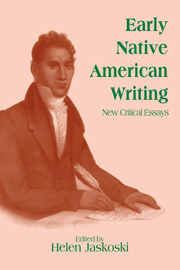Book contents
- Frontmatter
- Contents
- Foreword
- Preface
- List of Contributors
- 1 “Honoratissimi benefactores” Native American students and two seventeenth-century texts in the university tradition
- 2 “Pray Sir, consider a little”: Rituals of subordination and strategies of resistance in the letters of Hezekiah Calvin and David Fowler to Eleazar Wheelock
- 3 “(I speak like a fool but I am constrained)”: Samson Occom's Short Narrative and economies of the racial self
- 4 “Where, then, shall we place the hero of the wilderness?”: William Apess's Eulogy on King Philip and doctrines of racial destiny
- 5 “They ought to enjoy the home of their fathers”: The treaty of 1838, Seneca intellectuals, and literary genesis
- 6 “I am Joaquin!”: Space and freedom in Yellow Bird's The Life and Adventures of Joaquin Murieta, the Celebrated California Bandit
- 7 “This voluminous unwritten book of ours”: Early Native American writers and the oral tradition
- 8 “A terrible sickness among them”: Smallpox and stories of the frontier
- 9 “A desirable citizen, a practical business man”: G. W. Grayson – Creek mixed blood, nationalist, and autobiographer
- 10 “An Indian … An American”: Ethnicity, assimilation, and balance in Charles Eastman's From the Deep Woods to Civilization
- 11 “Overcoming all obstacles”: The assimilation debate in Native American women's journalism of the Dawes era
- 12 “My people … my kind”: Mourning Dove's Cogewea, The Half-Blood as a narrative of mixed descent
- 13 “Because I understand the storytelling art”: The evolution of D'Arcy McNickle's The Surrounded
8 - “A terrible sickness among them”: Smallpox and stories of the frontier
Published online by Cambridge University Press: 20 February 2010
- Frontmatter
- Contents
- Foreword
- Preface
- List of Contributors
- 1 “Honoratissimi benefactores” Native American students and two seventeenth-century texts in the university tradition
- 2 “Pray Sir, consider a little”: Rituals of subordination and strategies of resistance in the letters of Hezekiah Calvin and David Fowler to Eleazar Wheelock
- 3 “(I speak like a fool but I am constrained)”: Samson Occom's Short Narrative and economies of the racial self
- 4 “Where, then, shall we place the hero of the wilderness?”: William Apess's Eulogy on King Philip and doctrines of racial destiny
- 5 “They ought to enjoy the home of their fathers”: The treaty of 1838, Seneca intellectuals, and literary genesis
- 6 “I am Joaquin!”: Space and freedom in Yellow Bird's The Life and Adventures of Joaquin Murieta, the Celebrated California Bandit
- 7 “This voluminous unwritten book of ours”: Early Native American writers and the oral tradition
- 8 “A terrible sickness among them”: Smallpox and stories of the frontier
- 9 “A desirable citizen, a practical business man”: G. W. Grayson – Creek mixed blood, nationalist, and autobiographer
- 10 “An Indian … An American”: Ethnicity, assimilation, and balance in Charles Eastman's From the Deep Woods to Civilization
- 11 “Overcoming all obstacles”: The assimilation debate in Native American women's journalism of the Dawes era
- 12 “My people … my kind”: Mourning Dove's Cogewea, The Half-Blood as a narrative of mixed descent
- 13 “Because I understand the storytelling art”: The evolution of D'Arcy McNickle's The Surrounded
Summary
Histories of North America have largely ignored, marginalized, or discounted the contributions of Native North American historians. As a result, the official story has been, as Annette Kolodny says, “univocal and monolingual, defining origins by what later became the tropes of the dominant or conquering language” (12). Kolodny calls for a reopening of the frontier, a reassessment “thematizing frontier as a multiplicity of ongoing first encounters over time and land, rather than as a linear chronology of successive discoveries and discrete settlements. … There can be no paradigmatic first contact because there are so many first encounters. And there can be no single overarching story” (13). Richard White's detailed exploration of the history of the Great Lakes area from 1650 to 1815 is a step in the direction Kolodny proposes, but even this impressive revisionist account of the pays d'en haut, as he calls it, omits the work of Native historians. However, White's paradigm of the eighteenth-century northwest frontier as a space defined by multi-interest negotiation, compromise, and improvisation provides a useful framework for examining the ways in which nineteenth-century historians, writing in the context of literary romanticism, conceptualized the frontier of the previous century.
Colonial history of the Western Hemisphere fascinated American historians a hundred years later. Francis Parkman, George Bancroft, and Willard Motley perceived conflicts like the conquest of Mexico or Peru as the working out in the hemisphere of the destinies of the European world powers.
- Type
- Chapter
- Information
- Early Native American WritingNew Critical Essays, pp. 136 - 157Publisher: Cambridge University PressPrint publication year: 1996



